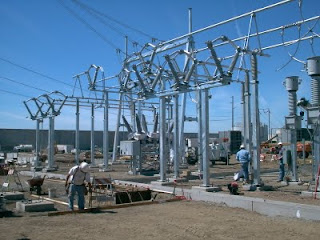First up, John, my Queens birthday honour for services to blogging about model railways has obviously got lost in the post. Privatise NZ post immediately to improve its performance (or just to sell off a perfectly good public asset to address a made up economic problem; your choice).
An extra day in a weekend care of Bettie the 2nd was not to be wasted. While the lady of the house sheltered inside with the lurgy, I ventured out into the man-sion with great and grand plans.
Purchases on Sunday at Spotlight and Jaycar gave me enough bits to make a start on point actuation for the second module. This involved lifting almost all of the track to put in the curtain wire. This was further complicated by the fact that it was glued down with PVA. I doused everything liberally with water to soften the glue. I then only had to defeat the double sided tape and the heavy duty copper droppers that had fitted. These had been bent over to avoid being knocked during the move so were very hard to move. The soldering iron soon removed them as well, but not before there was recourse to the superglue for first aid.
So, with the track all up, I then had to cut out the groves for the curtain wire to run through the base foam. this meant that I had to put the various track assemblies back to see where the curtain wire was going to run to the switches. For this module I decided to group the point throws into 2 different 'boxes', one with 6 and one with 7. After a bit of thought I decided not to try and separate out the controls for the mail line and the loco depot as this would be in the 'wee bit too hard' box.

When looking more closely at several of the track assemblies I noticed that I had neglected/not bothered to gap the PCB sleepers or cut the rail for the point frogs. At this point I must admit I just stopped and stared at the offending trackage for a couple of minutes. This had absolutely no effect, and so it was off to the workbench to sort it out. I'm sure if I was a woman the copper would have parted under my withering gaze. Men must make do with small files.
I took the opportunity to add a few more sleepers to hold everything together. Unfortunately I could not test the insulation properly as the brass braces at the module ends precluded this. I could confirm that the point frogs were insulated from the rest which is probably enough for the moment.
So, all in all it was one of those days when I probably should have given up when the mojo was not working, but I wasn't prepared to lose the day. I'm a wee bit further on, but it took an awful lot of work. Work which i should really have done the first time round on the workbench.
Just as a final note, the controls for the 13 points on this module are going to cost about $30. I dread to think how much I would be staring down the barrel of if I had gone with commercial points and point motors.
 This has improved the look no end. I will just have to sort out how to mount microtrains couplers to it as there is sod all room for them.
This has improved the look no end. I will just have to sort out how to mount microtrains couplers to it as there is sod all room for them.




























